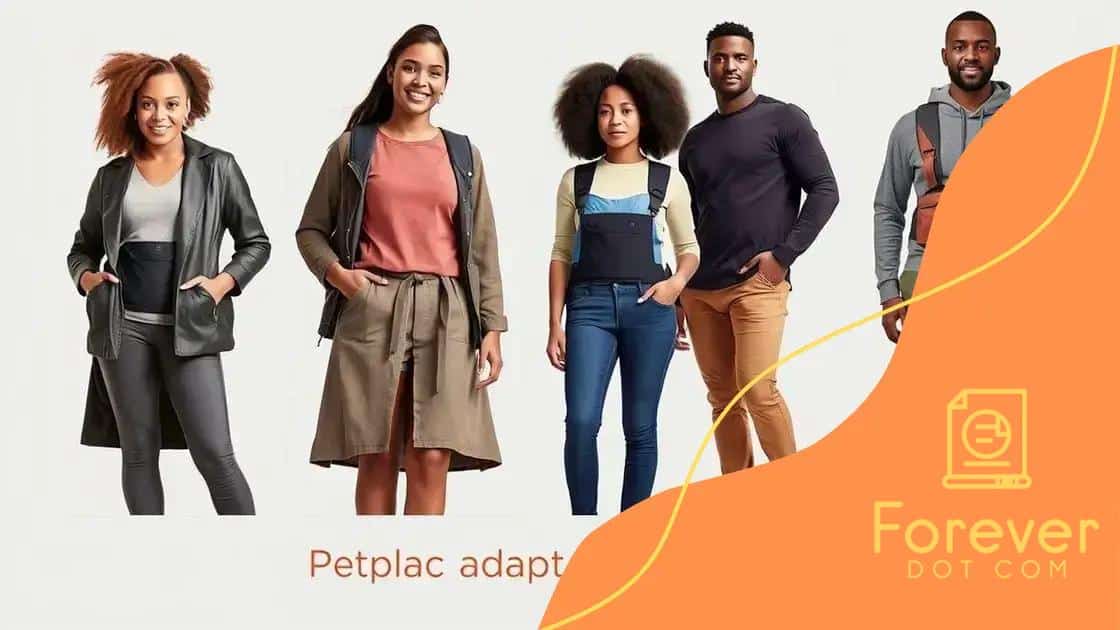The growing market for adaptive fashion: what you need to know

Adaptive fashion involves clothing designed specifically for individuals with disabilities, featuring innovations like magnetic closures and adjustable fits to enhance comfort and style while promoting inclusivity.
The growing market for adaptive fashion is not just a trend; it’s a response to the varied needs of individuals across the globe. Have you ever wondered how important it is for everyone to feel comfortable and stylish? Let’s dive into this fascinating world.
Understanding adaptive fashion and its importance
Understanding adaptive fashion is crucial as it caters to the diverse needs of individuals who face challenges with traditional clothing. This market is growing rapidly, providing options that enhance both style and comfort.
Adaptive fashion is not just about making clothes; it’s about creating garments that empower individuals. These innovative designs address specific physical needs while ensuring that everyone can express their identity and personal style.
What Sets Adaptive Fashion Apart?
Adaptive fashion includes features such as:
- Adjustable elements for fit and comfort
- Easy closures that accommodate different abilities
- Fashion-forward styles that do not compromise aesthetics
By focusing on these aspects, adaptive fashion brands are breaking barriers and eliminating stigmas around disabilities. Inclusivity in fashion is essential for helping everyone feel confident and seen.
Importance of Inclusion in the Fashion Industry
A major reason for the rise of adaptive fashion is the growing recognition of the need for inclusion. Many companies are now embracing diversity, realizing that their customer base goes beyond the average size or ability. This shift not only benefits those who require adaptive solutions but also enriches the entire fashion landscape.
Adaptive fashion allows individuals to express their unique personalities through their clothing choices. It creates a space where everyone can feel represented, fostering a sense of community and belonging.
Furthermore, adaptive fashion is an important step toward social responsibility in the industry. As brands invest in innovative designs that include all body types and abilities, they challenge outdated norms and inspire others to follow suit.
Key players in the adaptive fashion market
Key players in the adaptive fashion market are driving innovation and change in the fashion industry. These companies and designers are focused on creating clothing that meets the specific needs of individuals with disabilities.
Some of the leading brands include:
- Tommy Hilfiger: Known for their inclusive lines that enable people with disabilities to wear stylish clothing.
- Zappos: Offers a wide selection of adaptive clothing options from various brands, promoting accessibility and comfort.
- Target: Their adaptive clothing line provides fashionable options for children and adults, making inclusivity a priority.
- Uniqlo: Their clothing focuses on both functionality and style, catering to diverse needs.
These brands not only sell products but also advocate for a more inclusive approach to fashion. The importance of representation can’t be overstated, as these players help reshape the narrative around disability and style.
Emerging Brands Making a Difference
In addition to established brands, many emerging players are making waves in the adaptive fashion scene. These startups focus on innovative designs and unique solutions to meeting the needs of their customers. For example, brands like Open Style Lab provide personalized clothing designs for individuals with specific challenges, allowing for a truly customized experience.
Moreover, community-driven brands often engage directly with their customers to understand their needs. These connections allow for creative solutions, such as adjustable fits and easy-access features. The rapid growth of the adaptive fashion market showcases the increasing demand for clothing that is both stylish and functional.
Collaboration among designers, brands, and consumers is key to ensuring that adaptive fashion continues to evolve. As more voices join the conversation, the possibilities for innovation expand, leading to a richer fashion landscape where everyone can find their place.
Trends shaping the future of adaptive fashion

Trends shaping the future of adaptive fashion reflect a shift towards greater inclusivity and innovation. As society becomes more aware of the diverse needs of individuals, the fashion industry is evolving to meet these demands.
One major trend is the use of sustainable materials. Brands are increasingly prioritizing eco-friendly options, ensuring that fashion is both accessible and environmentally responsible. This approach makes adaptive clothing not only stylish but also ethical.
Technology in Adaptive Fashion
Another trend is the integration of technology. Wearable technology helps create clothing that adapts to the wearer’s needs. Features like moisture-wicking fabrics or temperature control are becoming more common.
- Smart textiles: Fabrics that respond to changes in the environment.
- 3D printing: Custom-fit solutions for specific physical needs.
- Mobile apps: Tools for users to customize their clothing choices.
This merging of technology and fashion personalizes the experience for individuals, enhancing both functionality and style.
Inclusivity in Design
The future of adaptive fashion also focuses on inclusive design principles. Brands are recognizing the importance of representing various body types and disabilities. By collaborating with people who have lived experiences, designers can create clothing that truly meets the needs of their audience.
Furthermore, the rise of social media has made it easier for brands to connect with consumers and receive feedback. This interaction fosters a community where everyone can share their ideas and experiences. As a result, adaptive fashion is becoming more responsive and relevant to the market.
Ultimately, the trends in adaptive fashion highlight a positive shift in the industry towards empathy, sustainability, and creativity, paving the way for a more inclusive future.
Design and innovation in adaptive clothing
Design and innovation in adaptive clothing are transforming the way people approach fashion and functionality. With a focus on making stylish and practical garments, designers are rethinking traditional clothing patterns.
One of the primary goals is to create clothes that are not only functional but also aesthetically pleasing. This shift has led to innovative features being integrated into designs.
Innovative Features in Adaptive Designs
Brands are now including:
- Magnetic closures: These are easier to use than traditional buttons and zippers, making dressing simpler for everyone.
- Adjustable fits: Clothing that can be modified for different body shapes helps in enhancing comfort and wearability.
- Stretchable materials: Fabrics that accommodate movement and flexibility are becoming a staple in adaptive clothing lines.
By emphasizing these features, designers are ensuring that clothing meets the actual needs of individuals, enhancing their daily lives.
Collaboration and Community Input
Collaboration between designers and individuals with disabilities has also played a significant role in innovation. By understanding the specific challenges that people face, designers create more relevant solutions. This process often results in groundbreaking ideas that challenge traditional notions of fashion.
Furthermore, leading brands are increasingly involving their customers in the design process through feedback and community engagement. This collaborative approach not only leads to better products but also fosters a greater sense of belonging within the fashion community.
As adaptive clothing continues to evolve, embracing creativity and practicality will likely lead to more exciting developments in the future. This ongoing evolution reflects a deeper understanding of the diverse needs of consumers, building a more inclusive fashion landscape.
How to choose the right adaptive fashion items
Choosing the right adaptive fashion items can greatly enhance comfort and confidence. With various options available, it’s important to consider specific needs and preferences.
First, think about the everyday challenges faced when dressing. Are traditional closures difficult to manage? Adaptive items often use features that simplify getting dressed, like:
- Velcro or magnetic fastenings: These offer easier access compared to buttons or zippers.
- Stretchable fabrics: Materials that adapt to your body shape provide more comfort and flexibility.
- Adjustable designs: Look for clothing that can be modified for size or fit to accommodate changes in your needs.
Next, pay attention to the style of the clothing. Just because it’s adaptive doesn’t mean it can’t be fashionable. Today’s adaptive fashion comes in various styles, colors, and patterns, allowing individuals to express their unique identities.
Considering Your Lifestyle
Your lifestyle greatly impacts your choices. Think about where you will wear the clothes. For instance, if you need attire for casual outings versus formal events, consider items that can be versatile. Fabrics that are durable and easy to clean are also practical for daily wear.
Don’t forget about layering. Items that can easily mix and match with other pieces allow for more outfit options, ensuring you feel great no matter the occasion.
Trying It On
Whenever possible, try on clothing before making a purchase. This way, you can determine if it accommodates your needs comfortably. Pay attention to how the garment feels when moving. It’s vital that clothing does not restrict movement.
Engaging with brands that focus on adaptive fashion can also provide insight into how their pieces were designed. Many companies promote inclusivity and understanding of diverse needs, which often leads to better product options.
In conclusion, adaptive fashion is a vital step towards inclusivity in the clothing industry. As we explore innovative designs and consider individual needs, we can make informed choices that enhance comfort and style. By focusing on versatile, functional, and stylish clothing, we empower everyone to express their unique identity. With key players leading the charge, adaptive fashion is set to continue evolving and making a positive impact on society.
FAQ – Frequently Asked Questions About Adaptive Fashion
What is adaptive fashion?
Adaptive fashion refers to clothing designed to be accessible and comfortable for people with disabilities, incorporating features that simplify dressing.
How do I choose the right adaptive clothing?
Consider factors like ease of use, comfort, style, and how well the clothing fits into your lifestyle when selecting adaptive items.
Are there specific brands known for adaptive fashion?
Yes, brands like Tommy Hilfiger, Target, and Zappos offer dedicated collections focusing on stylish and functional adaptive clothing.
What are some common features in adaptive clothing?
Common features include magnetic closures, stretchable fabrics, and adjustable fits, all designed to enhance usability and comfort.






